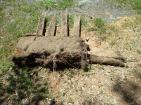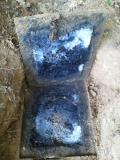Basic facts for how a conventional Septic System works:
A conventional Septic System works by having a septic tank for household waste to flow into.
Water flows into a distribution box. Distribution box distributes the water out into lines or pits.
(Pits are no longer installed due to possible contamination of ground water)
It must be remembered that the septic tank is part of the onsite sewage treatment system for a purpose. The purpose is to separate the sewage solids and to store them in the septic tank.
The solids in the septic tank are acted upon by bacteria, which break them down and reduce their volume. However, the volume of the solids is never reduced to zero and a residue builds up
in the septic tank.
The reside at the bottom is called sludge and the residue which floats to the surface of the tank is called scum. As sewage is discharged into the tank, the volume of sludge and scum increases.
The clear zone in the tank decreases and liquid flows through the tank faster. If the flow is to fast, sewage solids will be carried into the drain field. These solids plug the soil pores of the drain field
and slow down the flow of liquid into the soil. The pores in the in the drain field become clogged
with sewage solids.
The system can’t handle as much liquid as before and sewage eventually backs up or bubbles to the ground surface, depending on the relative elevation of the house and drain field.
Proper maintenance of the septic tank is to have the tank cleaned,
so the scum and sludge are removed.
It is far more costly to repair or replace a drainfield, than it would have been to have the septic tank cleaned property and on a routine maintenance schedule. All those who own and use an onsite sewage treatment system should be made aware of the proper use and maintenance of the system.
Regular inspections, tank pumping, and other maintenance activities are conducted by trained, licensed service providers.
Failing systems can cause public health risks and environmental damage and are expensive to repair. System owners should be made aware of the need for periodically removing tank sludge, maintaining system components, and operating systems within their design limitations to help maximize treatment effectiveness and extend the life of the systems.
Educating homeowners about the proper operation and maintenance of their treatment systems is an essential program activity.
Onsite system owners are often uninformed about how their systems function and the potential for ground water and surface water contamination from poorly functioning systems. Surveys show that many people have their septic tanks pumped only after the system backs up into their homes or yards. Responsible property owners who are educated in proper wastewater disposal and maintenance practices and understand the consequences of system failure are more likely to make an effort to ensure their systems are in compliance with operation and maintenance requirements.
Information taken from:
United States Environmental Protection Agency
Onsite Wastewater Treatment Systems Manual
Many homes have garbage disposals to help manage vegetable and other food waste. Excessive use of your garbage disposal may introduce a high level of unwanted solids into your system. Use disposals moderately and consider composting as an option to handle vegetable waste



